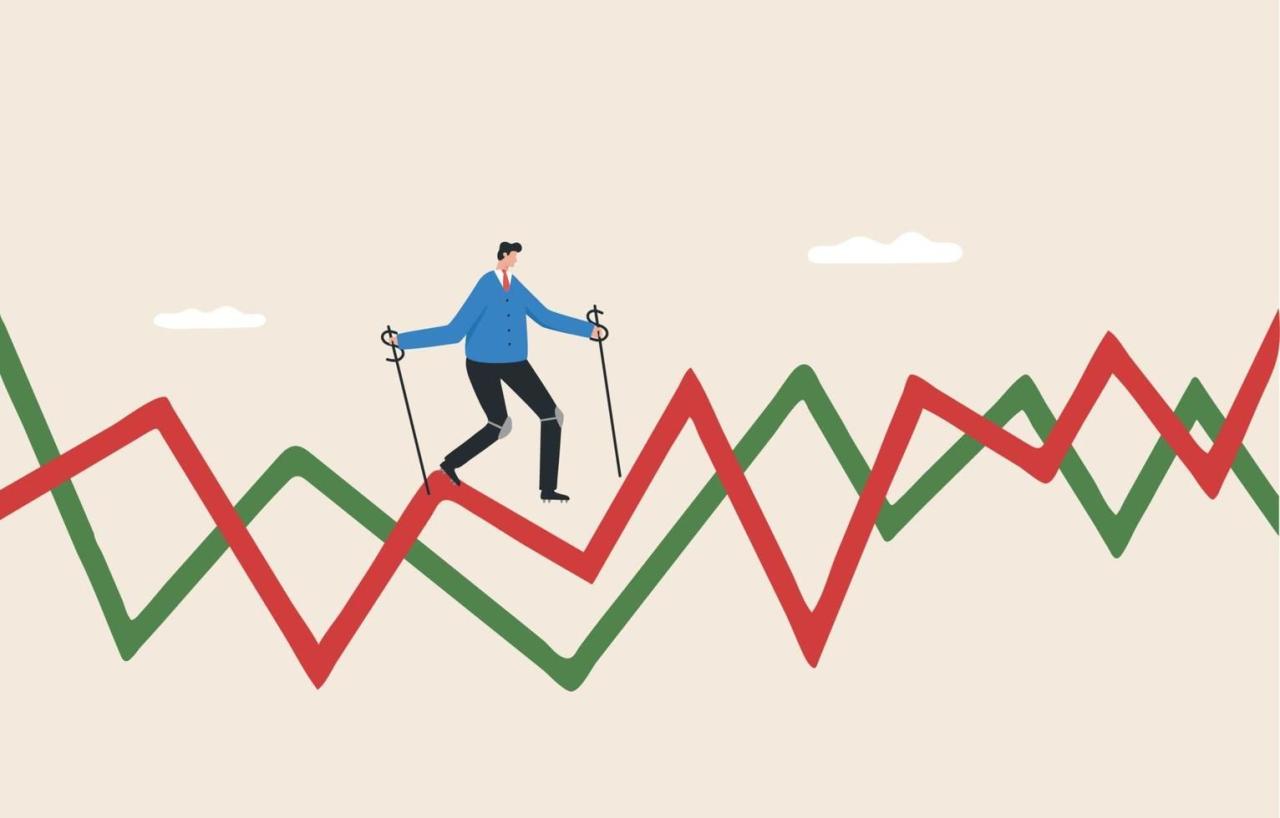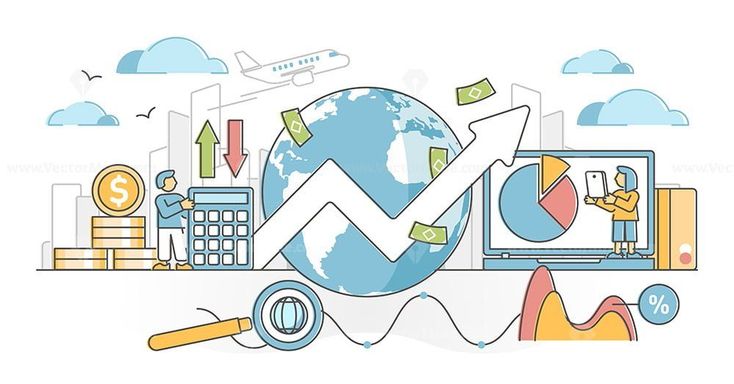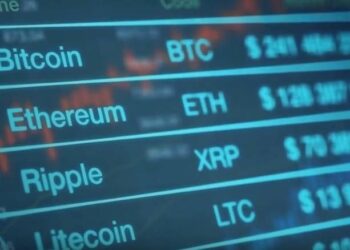The global financial landscape is a perpetually shifting tapestry, constantly influenced by a complex interplay of economic, geopolitical, technological, and social forces. In recent years, this environment has been characterized by an undeniable and often intense volatility, presenting both formidable challenges and unique opportunities for investors, businesses, and policymakers alike. Understanding and effectively navigating this turbulent sea is no longer an option but a critical imperative for survival and prosperity. From rapid fluctuations in stock indices to unpredictable swings in commodity prices and currency exchange rates, the ability to analyze, adapt, and strategize in the face of constant change is the hallmark of success in today’s interconnected global markets.
The New Normal: Understanding Volatility’s Roots
To effectively navigate the complexities of today’s global markets, it’s essential to first grasp the multifaceted factors that contribute to the heightened levels of volatility we’ve come to expect as the new normal. Gone are the days of predictable, steady growth; now, rapid and often unexpected shifts are commonplace.
A. Geopolitical Tensions and Regional Conflicts
The geopolitical landscape has become a primary driver of market uncertainty. Conflicts, trade disputes, and political instability in various regions can send immediate shockwaves across global exchanges.
- Trade Wars and Protectionism: Imposition of tariffs, retaliatory measures, and protectionist policies by major economies (e.g., historical US-China trade tensions) disrupt global supply chains, reduce international trade volumes, and create uncertainty for businesses reliant on cross-border commerce. This directly impacts corporate earnings and investor confidence.
- Regional Conflicts and Humanitarian Crises: Wars (e.g., ongoing conflicts in Eastern Europe or the Middle East) or humanitarian crises (e.g., widespread famine, refugee movements) create immediate instability. They can disrupt energy supplies, agricultural exports, and established trade routes, leading to spikes in commodity prices and shifts in investment flows towards perceived safe havens.
- Political Instability and Elections: Domestic political turmoil, unexpected election results, or changes in government policies (e.g., shifts in fiscal or monetary policy, regulatory changes) within key economies can trigger market apprehension, as investors re-evaluate the risk profile of affected regions.
- Sanctions and Diplomatic Relations: The imposition of economic sanctions against nations or entities, or the deterioration of diplomatic relations, can severely impact specific industries or entire economies, leading to asset re-pricing and increased risk premiums.
B. Inflationary Pressures and Monetary Policy Shifts
The battle against inflation has brought about significant shifts in central bank policies, directly impacting interest rates, borrowing costs, and asset valuations.
- Persistent Inflation Concerns: Supply chain disruptions (e.g., post-pandemic, geopolitical events), strong consumer demand, and tight labor markets have fueled inflationary pressures globally. Rising energy and food prices disproportionately affect consumer purchasing power and corporate margins.
- Aggressive Central Bank Tightening: In response to inflation, major central banks (e.g., the US Federal Reserve, European Central Bank, Bank of England) have embarked on aggressive interest rate hiking cycles. Higher rates increase borrowing costs for businesses and consumers, cool economic activity, and can make equity investments less attractive compared to fixed-income assets.
- Quantitative Tightening (QT): Beyond rate hikes, central banks have also engaged in quantitative tightening, reducing their balance sheets by selling off bonds accumulated during periods of quantitative easing. This removes liquidity from the financial system, putting upward pressure on long-term interest rates and increasing market volatility.
- Divergent Monetary Paths: Different central banks may pursue divergent monetary policies based on their unique economic conditions. This can lead to significant currency fluctuations, impacting the competitiveness of export-oriented economies and the returns on international investments.
C. Technological Disruption and Innovation Cycles
Rapid technological advancements, while offering immense opportunities, also introduce elements of disruption and uncertainty into established market structures.
- AI Revolution: The accelerating development and adoption of Artificial Intelligence across sectors is driving massive investment but also creating uncertainty regarding job markets, intellectual property, and the long-term competitive landscape for businesses that fail to adapt. Companies that are perceived as leaders in AI see massive valuations, while laggards face existential questions.
- Cybersecurity Threats: The increasing sophistication of cyberattacks poses a continuous threat to financial institutions, businesses, and critical infrastructure. Major cyber incidents can lead to significant financial losses, reputational damage, and erode investor confidence in affected entities or even entire sectors.
- Blockchain and Digital Assets: The emergence of blockchain technology and digital assets (e.g., cryptocurrencies, NFTs) has created entirely new, highly volatile markets. While offering innovative financial applications, their lack of traditional regulation and inherent speculative nature contribute to broader market volatility, sometimes spilling over into traditional asset classes.
- Disruption of Traditional Industries: Technology can rapidly disrupt established industries and business models (e.g., streaming services displacing traditional media, e-commerce transforming retail). This creates winners and losers, leading to significant shifts in sector valuations and stock market performance.
D. Economic Cyclicality and Shifting Fundamentals
Despite attempts at stabilization, economies remain cyclical, and underlying economic fundamentals are constantly evolving, leading to periods of expansion and contraction.
- Business Cycles: Economies naturally move through phases of expansion, peak, contraction (recession), and trough. Market volatility often increases during inflection points, such as the onset of a recession or the early stages of recovery, as investors re-price assets based on new economic outlooks.
- Labor Market Dynamics: Shifts in employment rates, wage growth, and labor force participation can signal inflationary pressures or economic weakness, influencing central bank decisions and consumer spending patterns.
- Consumer Spending and Confidence: Consumer confidence, driven by factors like employment prospects, inflation, and interest rates, directly impacts retail sales and overall economic growth. Shifts in confidence can lead to rapid market re-pricing.
- Supply Chain Resilience: Recent global events have highlighted the fragility of global supply chains. Disruptions (e.g., pandemics, geopolitical conflicts, natural disasters) can lead to product shortages, price spikes, and operational bottlenecks for businesses, impacting earnings and economic stability.
Key Principles for Navigating Volatile Global Markets
Operating in an environment defined by constant change demands a disciplined approach and adherence to time-tested principles that prioritize risk management, flexibility, and a long-term perspective.
A. Embrace Diversification Strategically
Diversification remains the cornerstone of risk management, but in volatile markets, it must be approached with enhanced strategic foresight.
- Asset Class Diversification: Spread investments across different asset classes, such as equities (stocks), fixed income (bonds), real estate, commodities, and alternative investments. Different asset classes react differently to market conditions.
- Geographical Diversification: Invest across various countries and regions to reduce reliance on any single economy. While global markets are interconnected, regional economic cycles and political stability can still offer insulation.
- Sector and Industry Diversification: Avoid overconcentration in a single industry or sector. Disruptions (e.g., technological obsolescence, regulatory changes) can severely impact specific sectors.
- Currency Diversification: For international investors, holding assets denominated in multiple currencies can mitigate risks associated with adverse currency fluctuations.
- Diversification of Investment Styles: Combine different investment styles (e.g., growth, value, income-focused) within your portfolio, as their performance can vary across market cycles.
B. Maintain a Long-Term Investment Horizon
While daily headlines scream about market swings, investors with a long-term investment horizon are better positioned to ride out short-term volatility.
- Focus on Fundamentals: Instead of reacting to daily price movements, focus on the underlying fundamentals of the companies or assets you invest in (e.g., earnings growth, balance sheet strength, competitive advantage, market share).
- Time in the Market, Not Timing the Market: Historical data consistently shows that attempting to perfectly time market entries and exits is exceedingly difficult and often leads to worse returns than simply staying invested over the long term.
- Compounding Returns: The power of compounding works best over extended periods, allowing initial investments and their earnings to grow exponentially over time, buffering against temporary drawdowns.
- Ignore Noise: A long-term perspective helps investors filter out the daily market noise, emotional reactions, and speculative frenzies that often lead to poor short-term decisions.
C. Practice Disciplined Risk Management
In volatile markets, disciplined risk management is paramount to preserving capital and ensuring sustainable growth.
- Define Risk Tolerance: Understand your personal or organizational risk tolerance and align your investment strategy accordingly. This includes emotional capacity for drawdowns.
- Position Sizing: Carefully size your investment positions to ensure that no single investment can disproportionately impact your overall portfolio if it performs poorly.
- Stop-Loss Orders: For shorter-term trading or specific positions, consider using stop-loss orders to automatically limit potential losses if an asset price falls beyond a predefined threshold.
- Regular Rebalancing: Periodically review and rebalance your portfolio to maintain your desired asset allocation. This often involves selling assets that have performed well (and now represent a larger portion of your portfolio) and buying those that have lagged, effectively “buying low and selling high” in a disciplined manner.
- Contingency Planning: For businesses, implement robust contingency plans for supply chain disruptions, energy price spikes, or sudden shifts in consumer demand.
D. Stay Informed, Yet Avoid Over-Reaction
In an information-rich environment, staying informed about global developments is crucial, but it must be balanced with a disciplined approach to avoid impulsive decisions.
- Reliable Information Sources: Seek out information from credible, diverse, and unbiased sources for economic data, geopolitical analysis, and market insights.
- Understand Context: Don’t just react to headlines. Understand the underlying context, potential causes, and likely duration of market-moving events. Distinguish between temporary shocks and fundamental shifts.
- Filter Noise: The 24/7 news cycle and social media are rife with speculation and emotional commentary. Develop strategies to filter out unproductive noise and focus on actionable intelligence.
- Consult Experts: For complex situations, consult with financial advisors, economists, or geopolitical analysts who can provide nuanced perspectives and help interpret market signals.
E. Focus on Quality and Strong Fundamentals
In times of uncertainty, investments in quality assets with strong underlying fundamentals tend to be more resilient.
- Strong Balance Sheets: Companies with low debt, robust cash flows, and healthy reserves are better positioned to weather economic downturns and capitalize on recovery.
- Durable Competitive Advantages: Invest in companies with a clear and sustainable competitive edge (e.g., strong brand, intellectual property, network effects, cost leadership). These “moats” protect profitability.
- Adaptable Business Models: Companies with agile and adaptable business models that can pivot in response to changing market conditions are more likely to thrive.
- Prudent Management: Look for companies with experienced, transparent, and shareholder-aligned management teams that have a proven track record of navigating challenging environments.
F. Consider Hedging Strategies
For sophisticated investors or businesses with significant exposure to market risks, hedging strategies can provide a layer of protection against adverse movements.
- Currency Hedging: Using financial instruments (e.g., currency forwards, options) to lock in exchange rates for future transactions, protecting against adverse currency fluctuations.
- Commodity Hedging: For businesses exposed to volatile raw material prices, using futures contracts or options to lock in future purchase prices.
- Portfolio Hedging: Using options, futures, or inverse ETFs to protect a broader equity portfolio against downside risk. Hedging adds complexity and costs and is typically for experienced investors.
Key Drivers of Volatility in Today’s Interconnected World
Beyond the immediate causes, understanding the underlying systemic drivers that amplify volatility in today’s globalized financial system is crucial for a complete picture.
A. Global Interconnectedness and Contagion Risk
The interconnected nature of global financial markets means that a crisis or significant event in one region can rapidly spread and impact others.
- Financial Contagion: Shocks originating in one market (e.g., a stock market crash, a banking crisis) can quickly spread across borders through direct financial linkages (e.g., cross-border loans, derivatives), common exposures, or investor sentiment.
- Supply Chain Interdependencies: Modern supply chains are highly globalized and often lean. Disruptions in one part of the world (e.g., factory shutdowns, port delays) can have ripple effects across numerous industries and countries, impacting production and prices globally.
- Information Diffusion: The speed and ubiquity of information (and misinformation) dissemination through global media and social networks can accelerate market reactions, amplifying volatility.
B. Algorithmic Trading and High-Frequency Trading (HFT)
The increasing dominance of automated trading systems contributes to rapid price movements and flash crashes.
- Speed of Execution: HFT algorithms execute trades in microseconds, reacting to market signals far faster than humans. This can lead to rapid price adjustments and exacerbate market moves during periods of stress.
- Liquidity Fragility: While HFT often provides liquidity during normal conditions, during sudden market shocks, these algorithms can quickly withdraw from the market, leading to a sudden drying up of liquidity and sharper price drops (flash crashes).
- Feedback Loops: Algorithmic trading can create self-reinforcing feedback loops, where selling triggers more selling (or buying triggers more buying), amplifying volatility.
C. Regulatory Frameworks and Their Evolution
The post-2008 financial crisis saw significant regulatory changes, but the evolution of these frameworks continues to impact market dynamics.
- Basel Accords and Bank Capital: Stricter capital requirements for banks (e.g., Basel III) have made the financial system more resilient but may also impact banks’ willingness to engage in certain market-making activities, potentially affecting liquidity during stress.
- Shadow Banking and Non-Bank Finance: A significant portion of financial activity has moved outside traditional regulated banking to the ‘shadow banking’ sector (e.g., hedge funds, private equity). This segment often operates with less oversight and can be a source of systemic risk and volatility.
- Digital Asset Regulation: Governments are grappling with how to regulate new digital asset markets. Lack of clear, consistent regulation contributes to the extreme volatility seen in cryptocurrencies, but future regulatory clarity could stabilize these markets.
D. Demographic Shifts and Social Factors
Long-term demographic trends and evolving social attitudes can profoundly influence consumption, savings, and investment patterns.
- Aging Populations: In many developed countries, aging populations require different investment strategies (e.g., more income-focused, less risk-tolerant), potentially shifting capital flows from growth assets to more conservative ones.
- Wealth Inequality: Growing wealth inequality can lead to social unrest and political pressures for wealth redistribution, which can create uncertainty for investors.
- Environmental, Social, and Governance (ESG) Investing: The increasing focus on ESG factors by investors is directing capital towards sustainable businesses and away from those perceived as environmentally or socially irresponsible, creating shifts in sector valuations.
- Social Media Influence: Social media platforms can rapidly amplify trends, sentiment, or even misinformation, leading to ‘meme stock’ phenomena or rapid shifts in public perception that can trigger short-term market volatility.
The Future of Navigating Global Market Volatility
The landscape of global markets will continue to evolve, bringing new challenges and requiring increasingly sophisticated approaches to navigation.
A. AI-Driven Market Analysis and Prediction
Artificial intelligence and machine learning will play an increasingly central role in market analysis, risk management, and potentially even prediction.
- Predictive Analytics: AI models will analyze vast datasets (financial news, social media sentiment, economic indicators, satellite imagery) to identify patterns, predict market movements, and alert investors to emerging risks or opportunities with greater accuracy and speed than human analysis.
- Automated Risk Management: AI-powered systems will continuously monitor portfolio risks, optimize hedging strategies, and execute automated rebalancing based on predefined parameters and real-time market conditions.
- Algorithmic Trading Evolution: The sophistication of algorithmic trading will continue to grow, leading to even faster execution, but also potentially more robust circuit breakers and adaptive strategies to prevent flash crashes.
B. Greater Emphasis on Resilience and Supply Chain Diversification
Lessons learned from recent global shocks will drive a greater emphasis on building more resilient economies and supply chains.
- Nearshoring/Friendshoring: Companies may shift production closer to home or to politically allied nations to reduce geopolitical and logistical risks, even if it comes at a higher cost.
- Redundancy and Buffer Stocks: Businesses may move away from ‘just-in-time’ inventory models towards holding more buffer stocks and establishing redundant supply routes to mitigate disruptions.
- Government Policy: Governments may offer incentives for reshoring critical industries (e.g., semiconductors, pharmaceuticals) to enhance national security and economic stability.
C. Evolution of Digital Assets and CBDCs
The digital asset space will continue to mature, with a potential increase in regulatory clarity and the emergence of Central Bank Digital Currencies (CBDCs).
- Regulatory Maturation: As governments develop clearer regulatory frameworks for cryptocurrencies and other digital assets, their volatility may decrease, attracting more institutional investment.
- CBDC Impact: The introduction of CBDCs by major central banks could revolutionize payment systems, potentially impacting commercial banks, cross-border transactions, and the overall monetary landscape, creating new market dynamics.
- Tokenization of Assets: The tokenization of traditional assets (e.g., real estate, art, private equity) on blockchain platforms could increase liquidity and accessibility, but also introduce new forms of market risk and volatility.
D. Climate Change and ESG Integration
Climate change and broader Environmental, Social, and Governance (ESG) factors will increasingly become mainstream considerations for investment and risk management.
- Climate Risk in Valuations: Physical climate risks (e.g., extreme weather events) and transition risks (e.g., policy shifts towards decarbonization) will be more directly priced into asset valuations, affecting company and sector performance.
- Green Investment Flows: Capital will increasingly flow towards sustainable industries and companies with strong ESG credentials, creating significant investment opportunities and putting pressure on less sustainable sectors.
- Carbon Pricing: The expansion of carbon pricing mechanisms globally will directly impact the profitability of carbon-intensive industries, leading to shifts in investment patterns.
E. Redefining Global Trade and Economic Blocs
The traditional multilateral trade system faces ongoing challenges, potentially leading to the formation of new economic blocs and regional trade agreements.
- Bilateral/Regional Deals: A greater focus on bilateral or regional trade agreements rather than large multilateral ones, potentially leading to more fragmented global trade.
- De-globalization vs. Re-globalization: A debate between forces pushing for de-globalization (reshoring, protectionism) and those for re-globalization (resilient, diversified global supply chains).
- New Trade Routes: Geopolitical shifts could lead to the development of alternative trade routes and economic partnerships, impacting traditional global trade flows.
Conclusion
The global financial markets of today are undeniably characterized by heightened and persistent volatility, driven by a confluence of interwoven geopolitical tensions, aggressive monetary policy shifts, relentless technological disruption, and evolving economic fundamentals. This turbulent environment presents a continuous challenge, but also rich opportunities, for those who are prepared to navigate its complexities with foresight and discipline.
Success in these dynamic conditions hinges on a strategic and adaptable approach. Embracing robust diversification, maintaining a steadfast long-term investment horizon, practicing disciplined risk management, and staying informed without succumbing to over-reaction are no longer just wise choices but critical imperatives. Looking ahead, the future of global markets will be further shaped by advancements in AI-driven analytics, a stronger emphasis on economic resilience, the maturation of digital assets, the pervasive impact of climate change, and the ongoing redefinition of global trade relationships. For investors, businesses, and policymakers alike, the ability to understand these forces and adapt continuously will be the ultimate determinant of prosperity in this era of ceaseless change. Navigating volatility today is not merely about surviving the storm, but about mastering the currents to chart a course for enduring success.













